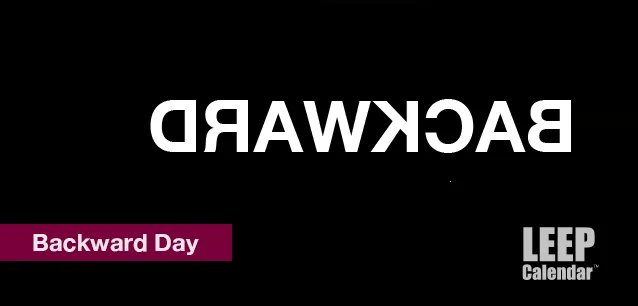 AD
AD
Today is: December 05
Scroll to explore events active on this date.
LEEP INK FEATURES

August? Absolutely!
In August, we live through the Dog Days of Summer. It's hot and often humid, and those who can leave for better climates do. Down south, winter is in full force. August is also known as "the ...

In The Heat of July: July 2025 Events
Is it hot enough (or cold enough if you're below the equator) for you yet? There is actually a day for that! Like every month, I pick a diverse collection of events you may or may not know about. This ...

May Blooms: Events in May 2025
Along with October, May is one of the most densely packed months of the year. It's before the summer humidity and the last whole month of the school year. The weather is warming in t...
About Backward Day
Ends: Jan 31, 2024
DESCRIPTION:
Backward Day is an organic celebration with no sponsor, celebrated worldwide. The basic concept of today? Do everything in reverse.
Eat dessert first.
Call people by their last names.
Read a book back to front.
Back into your parking space.
See how many palindromes you can identify (words spelled the same forward and back).
You get the idea!
Historically there is something called "Backwards Day," but there is no specific reason for designating January 31 to observe it.
The original Backwards Day occurred in the Julian Calendar (45BC-1582), the predecessor of the modern Gregorian calendar. Day one of the Gregorian calendar is October 15, 1582 (though it would be the mid-1700s before it became the standard in Europe and the rest of the world).
Because the Sun's rotation around the earth is just shy of 365 days, the way the Roman's dealt with this was to shift the calendar backward one day every 128 years. With the rise of Christianity, this became a problem. The vernal equinox determines Easter, and over centuries, the Julian calendar caused the vernal equinox to move backward by ten days.
With its leap year every four years, the Gregorian calendar solved this problem. The Gregorian calendar also assured that the vernal equinox would always fall at the same time every year.
VIDEOS
Currently, this event does not have supporting videos.
SUPPORTING DOCUMENTS
Currently, this event does not have supporting documents.
ADDITIONAL IMAGES
Currently, this event does not have supporting images.
Where would you like to go now?
 AD
AD


/footer-logo.svg)
